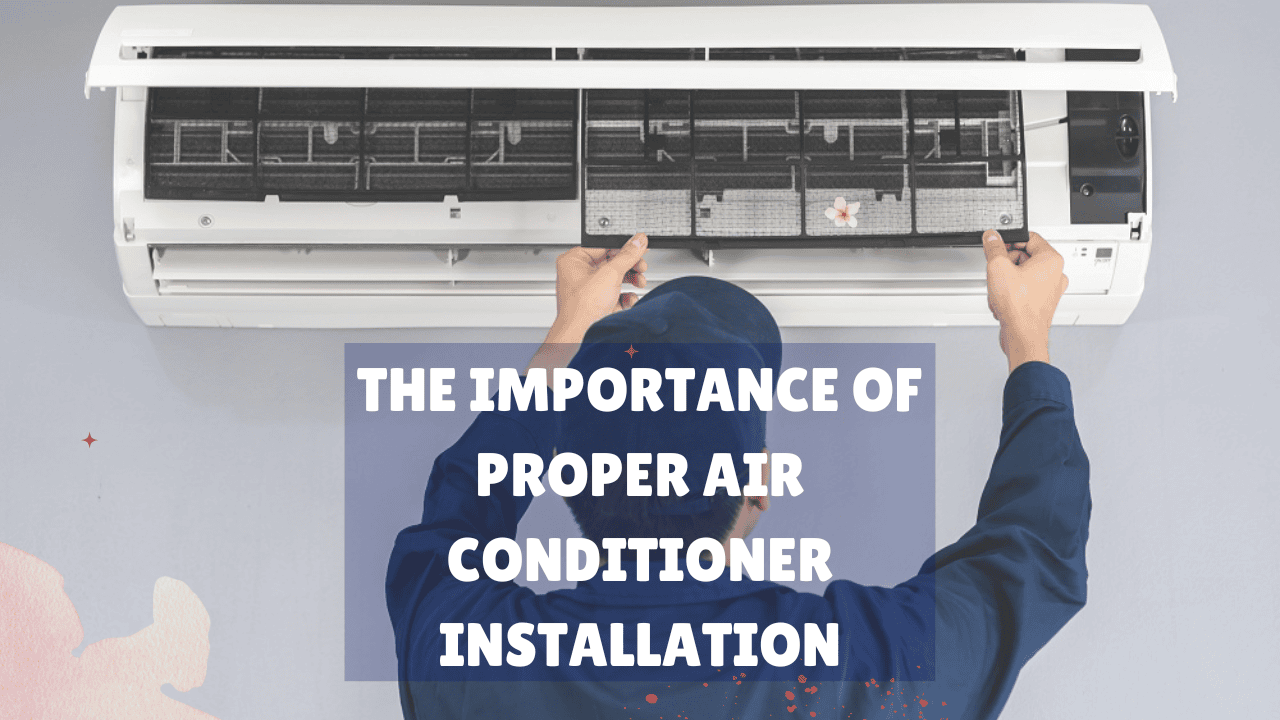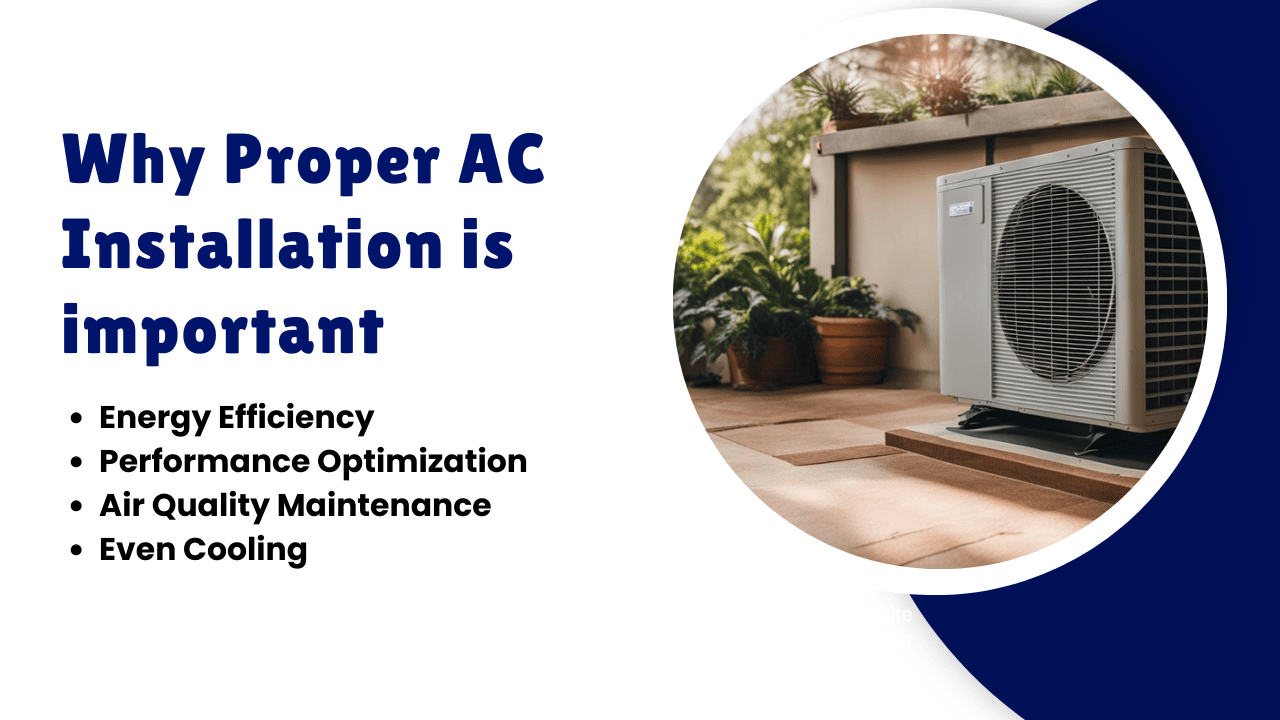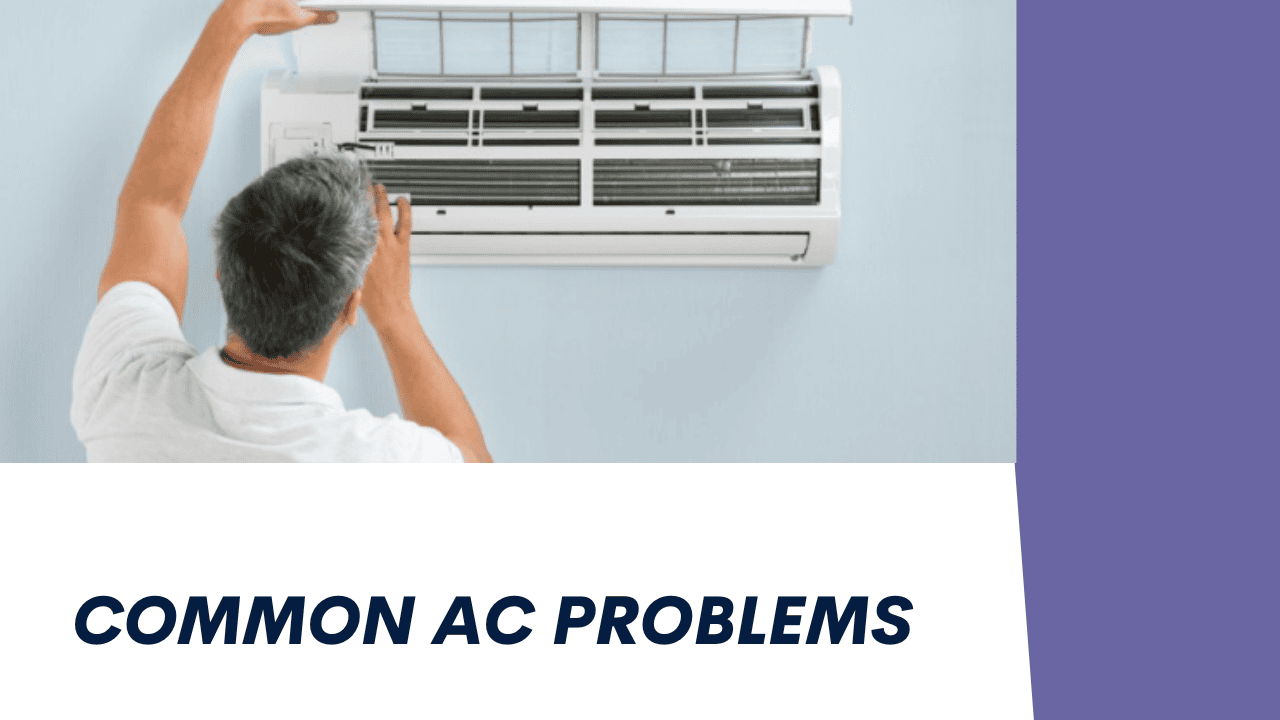The Importance of Proper Air Conditioner Installation: Key Checks for Optimal Performance


Are you tired of sweating it out in the summer heat? Or maybe you're fed up with sky-high energy bills? Well, the secret to a cool, comfortable home and lower utility costs lies in proper AC installation.
When your air conditioner is installed correctly, it works like a well-oiled machine. It's energy-efficient, keeps your home at the perfect temperature, and even helps maintain the air quality. But when it's not installed right, there can be several issues.
In this article, we’ll break down the importance of proper air conditioner installation. So, keep reading.
Why is Proper AC Installation Important?


Below we’ll discuss 7 points on this topic. Stay tuned and learn about them.
Energy Efficiency
The first reason for proper AC installation is it ensures your unit runs at peak efficiency. This means it uses less energy to cool your home, leading to lower electricity bills. An efficient AC also has a smaller carbon footprint, which is better for the environment.
Performance Optimization
Next, when an AC is installed correctly, it performs even better. It cools your home quickly and maintains a consistent temperature. As a result, you stay comfortable without frequently adjusting the thermostat.
Air Quality Maintenance
A well-installed AC filters the air more effectively. It’ll remove dust, pollen, and other allergens from your home and improve the air quality. Clean air is crucial for maintaining good health, especially for those with allergies or respiratory issues.
Even Cooling
Proper installation ensures that cool air is distributed evenly throughout your home. This eliminates hot and cold spots, providing a more comfortable living environment. Even cooling also reduces the strain on your AC unit, and extends the lifespan of the AC.
Reduced Repairs
If your AC unit is installed correctly then it’s less likely to experience problems. So, there will be fewer breakdowns and you’ll have to spend less money on repairs. Remember regular air conditioner maintenance is always important, but a properly installed system is the first step in ensuring longevity and reliability.
Warranty Protection
Many AC manufacturers require professional installation to honor their warranties. If you try to install the unit yourself or hire an unqualified person, you might void the warranty.
Safety Assurance
Finally, proper installation reduces the risk of electrical problems and refrigerant leaks. Both can be hazardous and cause serious health issues or even fires. Ensuring your AC is installed by a professional helps keep your home safe.
Some Crucial Aspects to Check During Air Conditioner Installation
To install the air conditioner properly you must follow some crucial aspects. Below we’ll be talking about 10 major aspects you should consider before installing an air conditioner.
- Proper Sizing: Make sure the AC unit matches the space it needs to cool. An oversized unit cools too fast and leaves humidity. An undersized unit runs too long and wastes energy.
- AC Positioning: Place the outdoor unit in a shaded area. Try to keep it away from direct sunlight and debris. This helps the unit run efficiently and prevents overheating.
- Ductwork Inspection: Check the ductwork for leaks, gaps, and proper insulation. Preventing air loss ensures that cool air reaches all parts of your home.
- Electrical Considerations: Ensure the wiring is correct and complies with safety codes. Faulty wiring can cause malfunctions and pose a safety risk.
- Air Conditioner Refrigerant Levels: Properly charge the refrigerant. Incorrect levels affect cooling efficiency and can damage the system over time.
- Airflow Optimization: Maintain unobstructed airflow around the indoor and outdoor units. Consistent cooling and maximum efficiency depend on proper airflow.
- Thermostat Calibration: Calibrate the thermostat accurately. Precise temperature control helps save energy and keeps your home comfortable.
- Condensate Drain: Ensure the condensate drain is working properly. Proper drainage prevents moisture buildup and mold growth inside the unit.
- Insulation: Insulate ducts and seal any gaps. It’ll minimize energy loss and keep the cooled air inside your home
- Quality Installation: Hire trained professionals for the installation. They ensure the unit is set up correctly and adheres to all standards.
Common AC Problems Due to Improper Installation


Now you’ll learn about some common problems of AC that can occur due to improper installation.
1. Poor Airflow
Improper installation of ductwork or positioning of the indoor unit can restrict airflow. Insufficient airflow prevents the AC from effectively distributing cooled air throughout the home. As a result, there will be problems like uneven cooling, where some rooms are colder than others.
2. Electrical Issues
Faulty wiring or improper electrical connections during installation can lead to electrical problems. This includes frequent tripping of circuit breakers, erratic operation of the AC unit, or even electrical hazards such as fires. Proper electrical considerations during installation are crucial to ensure safe and efficient operation of the AC system.
3. Refrigerant Problems
Improper charging of refrigerant or leaks in the refrigerant lines can cause significant issues. Low refrigerant levels reduce the cooling capacity of the AC, leading to inadequate cooling of the space. This not only affects comfort but can also damage the compressor over time, resulting in costly repairs.
4. Drainage Issues
If the condensate drain is not installed correctly or becomes clogged due to improper installation, it can lead to water leakage. Accumulated water around the indoor unit can cause water damage to walls, ceilings, and floors. Additionally, standing water promotes mold growth, which poses health risks to occupants.
5. Noise and Vibration
Due to incorrect installation of the outdoor unit or loose components excessive noise and vibration can occur during operation. This not only disrupts comfort but also indicates potential mechanical issues that may require repairs or adjustments.
6. Reduced Efficiency and Lifespan
Lastly, improper installation comprises the efficiency and lifespan of the AC system. It forces the unit to work harder than necessary, increases energy consumption, and accelerates wear and tear on components. As a result, there will be higher operating costs and require frequent repairs over time.
How to Know if AC is Installed Correctly?
Now if you want to ensure that your AC is installed correctly, there are several ways to check it. Let’s learn a bit about them.
1. Even Cooling
First, walk through each room and feel the air temperature. Check if your home has consistent temperatures in all rooms. If some rooms are warmer or cooler than others, there might be an installation issue. Proper installation ensures even cooling throughout the space, eliminating hot and cold spots.
2. Proper Airflow
Next, ensure air flows freely from all vents. To check it, place your hand near the vents to check for strong airflow. Blocked or weak airflow can indicate ductwork problems or an improperly sized unit. Consistent airflow from all vents is a sign of correct installation.
3. Minimal Noise
Listen for unusual sounds when the AC is running. If your AC is installed correctly it should operate quietly with only a gentle hum. Rattling, banging, or other loud noises can occur due to loose parts or improper installation. Minimal AC noise indicates the unit is securely and correctly installed.
4. No Water Leakage
Look for any signs of water leakage around the unit. Check for both indoors and outdoors. Also, check the area around the condensate drain and the outdoor unit. Proper installation prevents leaks and condensation buildup. Any water or air conditioner leakage can indicate issues with the condensate drain or improper sealing.
5. Optimum Performance
Monitor the unit's performance over time. It should cool the space efficiently and maintain the desired temperature without frequent cycling. Aside from that, check your energy bills for any unexpected spikes as this can indicate inefficiency. Optimum air conditioner performance means the AC unit is installed correctly and running at peak efficiency.
FAQs
1. What are the risks of improper A installation?
-Improper installation can lead to uneven cooling, poor airflow, increased noise, and higher operating costs. It may also void manufacturer warranties and pose safety hazards due to electrical or refrigerant issues.
2. What role does sizing play in AC installation?
-Choosing the right size AC unit ensures optimal performance. An oversized unit cools too quickly and cycles on and off frequently. On the other hand, an undersized unit struggles to cool the space efficiently, leading to discomfort and increased energy usage.
3. Can I install my AC unit myself to save money?
-Yes, but it's recommended to hire a professional to ensure it's done correctly and safely. Well, DIY installation may seem cost-effective, but it often results in improper setup and potential damage to the equipment.
Conclusion
So, there you have it! You’ve learned everything about proper AC installation. It is the key to a cool, comfortable, and cost-effective home. We’ve also discussed the ways to ensure your AC is installed correctly.
So, don't settle for anything less than the best - make sure your AC is installed right!

